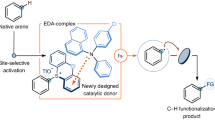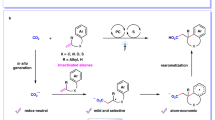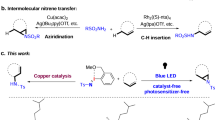Abstract
Catalytic carboxylation of C–H bonds using CO2 is a sustainable and economic strategy to produce valuable carboxylic acids. However, this process presents challenges due to the low reactivity of C–H bonds and difficulties in controlling regioselectivity. Although progress has been made in this field, catalytic carboxylation of C–H bonds in azines with CO2 is still a challenge. Here we report a visible-light-driven, thiolate-catalysed carboxylation of azine C(sp2)–H bonds using CO2. A variety of azines, including quinolines, pyridines, phenanthroline, naphthyridine and acridine, can undergo catalytic carboxylation to give N-heteroaromatic carboxylic acids in good yields and with excellent regiocontrol. This method operates under mild and transition-metal-free reaction conditions, is tolerant of a wide range of functional groups and is scalable. The utility of this method is demonstrated by application to the synthesis of bioactive molecules, such as cinchophen and brequinar derivatives, and to the modification of commonly used nitrogen ligands, including bipyridines, terpyridine and phenanthroline. Mechanistic investigations reveal the formation of an electron donor–acceptor complex between the thiolate catalyst and azine substrate.

This is a preview of subscription content, access via your institution
Access options
Subscribe to this journal
Receive 12 digital issues and online access to articles
$119.00 per year
only $9.92 per issue
Buy this article
- Purchase on Springer Link
- Instant access to full article PDF
Prices may be subject to local taxes which are calculated during checkout




Similar content being viewed by others
Data availability
The authors declare that the data supporting the findings of this study are available within the Article and its Supplementary Information files. Crystallographic data for the structures reported in this Article have been deposited at the Cambridge Crystallographic Data Centre, under deposition numbers CCDC 2223857 (2z), 2219986 (6e) and 2268054 (6f). Copies of the data can be obtained free of charge via https://www.ccdc.cam.ac.uk/structures/.
References
Liu, Q., Wu, L., Jackstell, R. & Beller, M. Using carbon dioxide as a building block in organic synthesis. Nat. Commun. 6, 5933 (2015).
Wang, S. & Xi, C. Recent advances in nucleophile-triggered CO2-incorporated cyclization leading to heterocycles. Chem. Soc. Rev. 48, 382–404 (2019).
Grignard, B., Gennen, S., Jérôme, C., Kleij, A. W. & Detrembleur, C. Advances in the use of CO2 as a renewable feedstock for the synthesis of polymers. Chem. Soc. Rev. 48, 4466–4514 (2019).
Cai, B., Cheo, H. W., Liu, T. & Wu, J. Light-promoted organic transformations utilizing carbon-based gas molecules as feedstocks. Angew. Chem. Int. Ed. 60, 18950–18980 (2021).
Ye, J.-H., Ju, T., Huang, H., Liao, L.-L. & Yu, D.-G. Radical carboxylative cyclizations and carboxylations with CO2. Acc. Chem. Res. 54, 2518–2531 (2021).
He, M., Sun, Y. & Han, B. Green carbon science: efficient carbon resource processing, utilization, and recycling towards carbon neutrality. Angew. Chem. Int. Ed. 61, e202112835 (2022).
Huang, K., Sun, C.-L. & Shi, Z.-J. Transition-metal-catalyzed C–C bond formation through the fixation of carbon dioxide. Chem. Soc. Rev. 40, 2435–2452 (2011).
Tortajada, A., Juliá-Hernández, F., Börjesson, M., Moragas, T. & Martin, R. Transition-metal-catalyzed carboxylation reactions with carbon dioxide. Angew. Chem. Int. Ed. 57, 15948–15982 (2018).
Yeung, C. S. Photoredox catalysis as a strategy for CO2 incorporation: direct access to carboxylic acids from a renewable feedstock. Angew. Chem. Int. Ed. 58, 5492–5502 (2019).
Zhang, L., Li, Z., Takimoto, M. & Hou, Z. Carboxylation reactions with carbon dioxide using N-heterocyclic carbene–copper catalysts. Chem. Rec. 20, 494–512 (2020).
Zhang, Z. et al. Visible-light-driven catalytic reductive carboxylation with CO2. ACS Catal. 10, 10871–10885 (2020).
He, X., Qiu, L.-Q., Wang, W.-J., Chen, K.-H. & He, L.-N. Photocarboxylation with CO2: an appealing and sustainable strategy for CO2 fixation. Green Chem. 22, 7301–7320 (2020).
Zhang, G., Cheng, Y., Beller, M. & Chen, F. Direct carboxylation with carbon dioxide via cooperative photoredox and transition-metal dual catalysis. Adv. Synth. Catal. 363, 1583–1596 (2021).
Maag, H. Prodrugs of Carboxylic Acids (Springer, 2007).
Gooβen, L., Rodríguez, J. N. & Gooβen, K. Carboxylic acids as substrates in homogeneous catalysis. Angew. Chem. Int. Ed. 47, 3100–3120 (2008).
Ackermann, L. Transition-metal-catalyzed carboxylation of C–H bonds. Angew. Chem. Int. Ed. 50, 3842–3844 (2011).
Tommasi, I. Direct carboxylation of C(sp3)–H and C(sp2)–H bonds with CO2 by transition-metal-catalyzed and base-mediated reactions. Catalysts 7, 380 (2017).
Gui, Y.-Y., Zhou, W.-J., Ye, J.-H. & Yu, D.-G. Photochemical carboxylation of activated C(sp3)–H with CO2. ChemSusChem 10, 1337–1340 (2017).
Hong, J., Li, M., Zhang, J., Sun, B. & Mo, F. C–H bond carboxylation with carbon dioxide. ChemSusChem 12, 6–39 (2019).
Pimparkar, S. et al. Recent advances in the incorporation of CO2 for C–H and C–C bond functionalization. Green Chem. 23, 9283–9317 (2021).
Zhang, L., Cheng, J., Ohishi, T. & Hou, Z. Copper-catalyzed direct carboxylation of C–H bonds with carbon dioxide. Angew. Chem. Int. Ed. 49, 8670–8673 (2010).
Boogaerts, I. I., Fortman, G. C., Furst, M. R., Cazin, C. S. & Nolan, S. P. Carboxylation of N–H/C–H bonds using N-heterocyclic carbene copper(I) complexes. Angew. Chem. Int. Ed. 49, 8674–8677 (2010).
Mizuno, H., Takaya, J. & Iwasawa, N. Rhodium(I)-catalyzed direct carboxylation. of arenes with CO2 via chelation-assisted C–H bond activation. J. Am. Chem. Soc. 133, 1251–1253 (2011).
Sasano, K., Takaya, J. & Iwasawa, N. Palladium(II)-catalyzed direct carboxylation of alkenyl C–H bonds with CO2. J. Am. Chem. Soc. 135, 10954–10957 (2013).
Michigami, K., Mita, T. & Sato, Y. Cobalt-catalyzed allylic C(sp3)–H carboxylation with CO2. J. Am. Chem. Soc. 139, 6094–6097 (2017).
Fu, L. et al. Ligand-enabled site-selectivity in a versatile rhodium(II)-catalysed aryl C–H carboxylation with CO2. Nat. Catal. 1, 469–478 (2018).
Pei, C., Zong, J., Han, S., Li, B. & Wang, B. Ni-catalyzed direct carboxylation of an unactivated C–H bond with CO2. Org. Lett. 22, 6897–6902 (2020).
Börjesson, M. et al. Remote sp2 C–H carboxylation via catalytic 1,4-Ni migration with CO2. J. Am. Chem. Soc. 142, 16234–16239 (2020).
Saito, T., Caner, J., Toriumi, N. & Iwasawa, N. Rhodium-catalyzed meta-selective C–H carboxylation reaction of 1,1-diarylethylenes via hydrorhodation–rhodium migration. Angew. Chem. Int. Ed. 60, 23349–23356 (2021).
Kemper, G., Hölscher, M. & Leitner, W. Pd(II)-catalyzed carboxylation of aromatic C–H bonds with CO2. Sci. Adv. 9, eadf2966 (2023).
Ishida, N., Masuda, Y., Uemoto, S. & Murakami, M. A light/ketone/copper system for carboxylation of allylic C–H bonds of alkenes with CO2. Chem. Eur. J. 22, 6524–6527 (2016).
Seo, H., Katcher, M. H. & Jamison, T. F. Photoredox activation of carbon dioxide for amino acid synthesis in continuous flow. Nat. Chem. 9, 453–456 (2017).
Ishida, N., Masuda, Y., Imamura, Y., Yamazaki, K. & Murakami, M. Carboxylation of benzylic and aliphatic C–H bonds with CO2 induced by light/ketone/nickel. J. Am. Chem. Soc. 141, 19611–19615 (2019).
Meng, Q. Y., Schirmer, T. E., Berger, A. L., Donabauer, K. & König, B. Photocarboxylation of benzylic C–H Bonds. J. Am. Chem. Soc. 141, 11393–11397 (2019).
Schmalzbauer, M. et al. Redox-neutral photocatalytic C–H carboxylation of arenes and styrenes with CO2. Chem 6, 2658–2672 (2020).
Khan, E. Pyridine derivatives as biologically active precursors; organics and selected coordination complexes. ChemistrySelect 6, 3041–3064 (2021).
Ghodsi, R., Zarghi, A., Daraei, B. & Hedayati, M. Design, synthesis and biological evaluation of new 2,3-diarylquinoline derivatives as selective cyclooxygenase-2 inhibitors. Bioorg. Med. Chem. 18, 1029–1033 (2010).
Madak, J. T. et al. Design, synthesis, and biological evaluation of 4-quinoline carboxylic acids as inhibitors of dihydroorotate dehydrogenase. J. Med. Chem. 61, 5162–5186 (2018).
Weyesa, A. & Mulugeta, E. Recent advances in the synthesis of biologically and pharmaceutically active quinoline and its analogues: a review. RSC Adv. 10, 20784–20793 (2020).
Meng, Q. Y., Wang, S. & König, B. Carboxylation of aromatic and aliphatic bromides and triflates with CO2 by dual visible-light-nickel catalysis. Angew. Chem. Int. Ed. 56, 13426–13430 (2017).
Ma, C. et al. Nickel-catalyzed carboxylation of aryl and heteroaryl fluorosulfates using carbon dioxide. Org. Lett. 21, 2464–2467 (2019).
Fuchs, P., Hess, U., Holst, H. H. & Lund, H. Electrochemical carboxylation of some heteroaromatic compounds. Acta Chem. Scand. B 35, 185–192 (1981).
Khoshro, H., Zare, H. R., Jafari, A. A. & Gorji, A. Dual activity of electrocatalytic activated CO2 toward pyridine for synthesis of isonicotinic acid: an EC′C′C mechanism. Electrochem. Commun. 51, 69–71 (2015).
Zhao, Z. et al. Site-selective electrochemical C–H carboxylation of arenes with CO2. Angew. Chem. Int. Ed. 62, e202214710 (2023).
Sun, G.-Q. et al. Electrochemical reactor dictates site selectivity in N-heteroarene carboxylations. Nature 615, 67–72 (2023).
Lima, C. G. S., Lima, T. D., Duarte, M., Jurberg, I. D. & Paixão, M. W. Organic synthesis enabled by light-irradiation of EDA complexes: theoretical background and synthetic applications. ACS Catal. 6, 1389–1407 (2016).
Crisenza, G. E. M., Mazzarella, D. & Melchiorre, P. Synthetic methods driven by the photoactivity of electron donor–acceptor complexes. J. Am. Chem. Soc. 142, 5461–5476 (2020).
Li, H., Liu, Y. & Chiba, S. Leveraging of sulfur anions in photoinduced molecular transformations. JACS Au 1, 2121–2129 (2021).
Wang, S., Wang, H. & König, B. Light-induced single-electron transfer processes involving sulfur anions as catalysts. J. Am. Chem. Soc. 143, 15530–15537 (2021).
Zhang, W. et al. Arylcarboxylation of unactivated alkenes with CO2 via visible-light photoredox catalysis. Nat. Commun. 14, 3529 (2023).
Saux, E. L., Georgiou, E., Dmitriev, I. A., Hartley, W. C. & Melchiorre, P. Photochemical organocatalytic functionalization of pyridines via pyridinyl radicals. J. Am. Chem. Soc. 145, 47–52 (2023).
Todres, Z. V. Ion-Radical Organic Chemistry: Principles and Applications (CRC Press, 2008).
You, Y. et al. Electrochemical dearomative dicarboxylation of heterocycles with highly negative reduction potentials. J. Am. Chem. Soc. 144, 3685–3695 (2022).
Ye, J.-H. et al. Visible-light-driven iron-promoted thiocarboxylation of styrenes and acrylates with CO2. Angew. Chem. Int. Ed. 56, 15416–15420 (2017).
Ju, T. et al. Dicarboxylation of alkenes, allenes and (hetero) arenes with CO2 via visible-light photoredox catalysis. Nat. Catal. 4, 304–311 (2021).
Chatterjee, A. & König, B. Birch-type photoreduction of arenes and heteroarenes by sensitized electron transfer. Angew. Chem. Int. Ed. 58, 14289–14294 (2019).
Cole, J. P. et al. Organocatalyzed Birch reduction driven by visible light. J. Am. Chem. Soc. 142, 13573–13581 (2020).
Crooks, R. M. & Bard, J. A. Electrochemistry in near-critical and supercritical fluids: part V. The dimerization of quinoline and acridine radical anions and dianions in ammonia from −70 °C to 150 °C. J. Electroanal. Chem. 240, 253–280 (1988).
Carelli, V. et al. On the regio- and stereoselectivity of pyridinyl radical dimerization. New J. Chem. 22, 999–1004 (1998).
Meng, Q.-Y., Wang, S. & König, B. Carboxylation of aromatic and aliphatic bromides and triflates with CO2 by dual visible-light–nickel catalysis. Angew. Chem. Int. Ed. 56, 13426–13430 (2019).
Huang, Y. et al. A versatile catalyst-free redox system mediated by carbon dioxide radical and dimsyl anions. Cell Rep. Phys. Sci. 3, 100994 (2022).
Prabagar, B., Yang, Y. & Shi, Z. Site-selective C–H functionalization to access the arene backbone of indoles and quinolines. Chem. Soc. Rev. 50, 11249–11269 (2021).
Shao, M. et al. Discovery and identification of PIM-1 kinase inhibitors through a hybrid screening approach. Mol. Diversity 18, 335–344 (2014).
Zhao, Z. et al. Palladium-catalyzed three-component cascade reaction of nitriles: synthesis of 2-arylquinoline-4-carboxylates. Org. Lett. 23, 7955–7960 (2021).
Liu, C., Li, K. & Shang, R. Arenethiolate as a dual function catalyst for photocatalytic defluoroalkylation and hydrodefluorination of trifluoromethyls. ACS Catal. 12, 4103–4109 (2022).
Majhi, J. et al. Practical, scalable, and transition metal-free visible light-induced heteroarylation route to substituted oxindoles. Chem. Sci. 14, 897–902 (2023).
Liu, Z., Lu, T. & Chen, Q. An sp-hybridized all-carboatomic ring, cyclo[18]carbon: electronic structure, electronic spectrum, and optical nonlinearity. Carbon 165, 461–467 (2020).
Domingo, L. R. & Pérez, P. Global and local reactivity indices for electrophilic/nucleophilic free radicals. Org. Biomol. Chem. 11, 4350–4358 (2013).
Lu, T. & Chen, F. Multiwfn: a multifunctional wavefunction analyzer. J. Comput. Chem. 33, 580–592 (2012).
Paton, R. patonlab/Kinisot v.2.0.1. Zenodo; https://doi.org/10.5281/zenodo.6831009 (2022).
Glmez-Gallego, M. & Sierra, M. A. Kinetic Isotope effects in the study of organometallic reaction mechanisms. Chem. Rev. 111, 4857–4963 (2011).
Alegre-Requena, J. V., Marqués-López, E. & Herrera, R. P. Optimizing the accuracy and computational cost in theoretical squaramide catalysis: the Henry reaction. Chem. Eur. J. 23, 15336–15347 (2017).
Acknowledgements
Financial support was provided by the National Natural Science Foundation of China (22225106 (D.-G.Y.), 22101191 (W.Z.), 22201027 (L.-L.L.)), Fundamental Research Funds from Sichuan University (2020SCUNL102 (D.-G.Y.)), the China Scholarship Council (202206240054 (W.Z.)) and the Fundamental Research Funds for the Central Universities. We thank X. Qi from Wuhan University for valuable discussion and help. We also thank X. Wang from the Analysis and Testing Center of Sichuan University and J. Li, Q. Zhang and D. Deng from the College of Chemistry at Sichuan University for compound testing.
Author information
Authors and Affiliations
Contributions
D.-G.Y. and J.-H.Y. conceived and designed the study. Y.-X.J., L.-L.L., J.-H.Y., Y.L. and D.-G.Y. wrote the paper. Y.-X.J., L.-L.L., T.-Y.G., W.-H.X., W.Z., L.S. and G.-Q. S. performed the experiments and mechanistic studies. L.-L.L. did the DFT calculations under supervision from Y.L. All authors contributed to the analysis and interpretation of the data.
Corresponding authors
Ethics declarations
Competing interests
D.-G.Y., Y.-X.J., T.-Y.G., L.-L.L., W.Z., L.S. and J.-H.Y. have applied for a Chinese patent (202210655523.4) relating to this work. The other authors declare no competing interests.
Peer review
Peer review information
Nature Synthesis thanks Juan Alegre-Requena and the other, anonymous, reviewer(s) for their contribution to the peer review of this work. Primary Handling Editor: Thomas West, in collaboration with the Nature Synthesis team.
Additional information
Publisher’s note Springer Nature remains neutral with regard to jurisdictional claims in published maps and institutional affiliations.
Supplementary information
Supplementary Information
Supplementary methods, references, Figs. 1–12 and Tables 1–3.
Supplementary Data 1
Crystallographic data for compound 2z (CCDC reference 2223857).
Supplementary Data 2
Crystallographic data for compound 6e (CCDC reference 2219986).
Supplementary Data 3
Crystallographic data for compound 6f (CCDC reference 2268054).
Rights and permissions
Springer Nature or its licensor (e.g. a society or other partner) holds exclusive rights to this article under a publishing agreement with the author(s) or other rightsholder(s); author self-archiving of the accepted manuscript version of this article is solely governed by the terms of such publishing agreement and applicable law.
About this article
Cite this article
Jiang, YX., Liao, LL., Gao, TY. et al. Visible-light-driven synthesis of N-heteroaromatic carboxylic acids by thiolate-catalysed carboxylation of C(sp²)–H bonds using CO2. Nat. Synth 3, 394–405 (2024). https://doi.org/10.1038/s44160-023-00465-6
Received:
Accepted:
Published:
Issue Date:
DOI: https://doi.org/10.1038/s44160-023-00465-6



